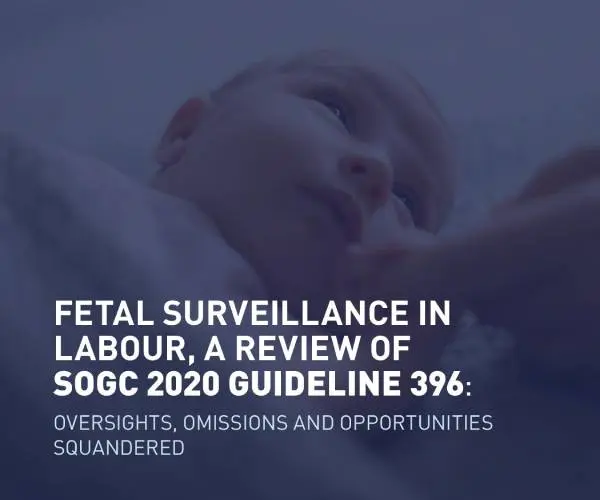Fetal Surveillance in Labour, a Review of SOGC 2020 Guideline 396: Oversights, Omissions, and Opportunities Squandered

Written By: Richard C. Halpern, Senior Counsel & Lawyer
An executive summary
New guidelines for fetal surveillance in labour, Clinical Practice Guideline No. 396, were issued by the Society of Obstetricians and Gynecologists of Canada (SOGC) in March 2020. In my view, this new Guideline has little hope of improving the care of mothers and babies during labour and delivery, fails to adequately describe how and when newborn neurological injury relates to events occurring during labour and makes recommendations based on data of dubious clinical value. My detailed critique of the new Guideline can be downloaded. In my analysis, I argue that the best defence to birth trauma litigation is not defence oriented guidelines, but improved neonatal outcomes. Further, improved neonatal outcomes depend on a firm understanding of how and when babies get injured in labour. Here, I offer an Executive Summary of that critique. In my critique, I address the following issues arising out of SOGC Guideline No. 396: With regard to how and when newborn neurological injury is related to events occurring during labour and delivery, “causation,” the Guideline:
- Fails to note and acknowledge the importance of newborn neuroimaging (head ultrasound, CT scan and, most critically, MRI) for proving acute neurological injury is connected to labour and delivery;
- Fails to recognize the importance of Fetal Heart Rate (FHR) patterns in demonstrating the timing of injury;
- Mistakenly describes the need for certain clinical features as essential for establishing causation, including:
- Incorrect or inaccurate conclusions about the importance of fetal multi-organ injury;
- Incorrect or inaccurate conclusions about the significance of acidosis in umbilical cord blood gas analysis;
- Neglecting to recognize that Cerebral Palsy (CP) is not the only outcome associated with birth asphyxia;
- Fails to update its conclusions about causation with other data, including recent guidelines from the American College of Obstetricians and Gynecologists (ACOG).
Concerning the mode of fetal surveillance in labour, the Guideline continues to promote Intermittent Auscultation (IA) in low-risk labour, rather than continuous Electronic Fetal Monitoring (EFM), based on dubious support from the data, an inadequate assessment of the risks and shortcomings of IA, and incomplete analysis of disclosure to the patient and informed consent.
Concerning the use of EFM to monitor fetal well-being, the Guideline:
- Fails to recognize that EFM, appropriately used, is expected to lead to a healthy newborn – always a “false-positive”;
- Provides some good analysis of the importance of the depth, duration and recovering of FHR decelerations;
- Has a scattered and incomplete treatment of the importance of FHR variability;
- Provides inadequate analysis of the significance of prolonged FHR decelerations;
- Subtly alters the clinical importance of early decelerations, without scientific support;
- Neglects to include some essential clinical features of variable decelerations; and
- Falls dramatically short of providing meaningful guidance on how fetal heart surveillance is to be used in the context of the overall clinical picture.
With regard to uterine activity, the Guideline:
- Provides a new, overly broad and imprecise definition of tachysystole, for excessive uterine activity;
- Neglects to provide sufficient direction regarding the importance of excessive uterine activity in the overall clinical picture and labour and delivery management.
Families are being put at risk
In my paper, I discuss these issues thoroughly, with appropriate scientific references. The importance of neuroimaging of the newborn brain is vital to understanding causation. It provides definitive proof of how and when the injury occurred, and its importance cannot be diminished by any other clinical markers that seem discordant. Neuroimaging establishes a well-defined window of opportunity for injury, within days and even hours. Fetal heart rate patterns can be used to refine or narrow that window of opportunity for injury. Properly applying the differential diagnosis, the timing and cause of injury will be established in this context. The new Guideline has not made any material contribution to improving intrapartum surveillance and offers little hope of improved neonatal outcomes. Indeed, it is my opinion that, with this Guideline, unacceptable levels of completely avoidable newborn brain injury will continue unabated. This is at enormous cost to our health care system, our tort system, and, more distressingly, creates an intolerable burden for affected families. Contact me at halpern@gluckstein.com for more information.
